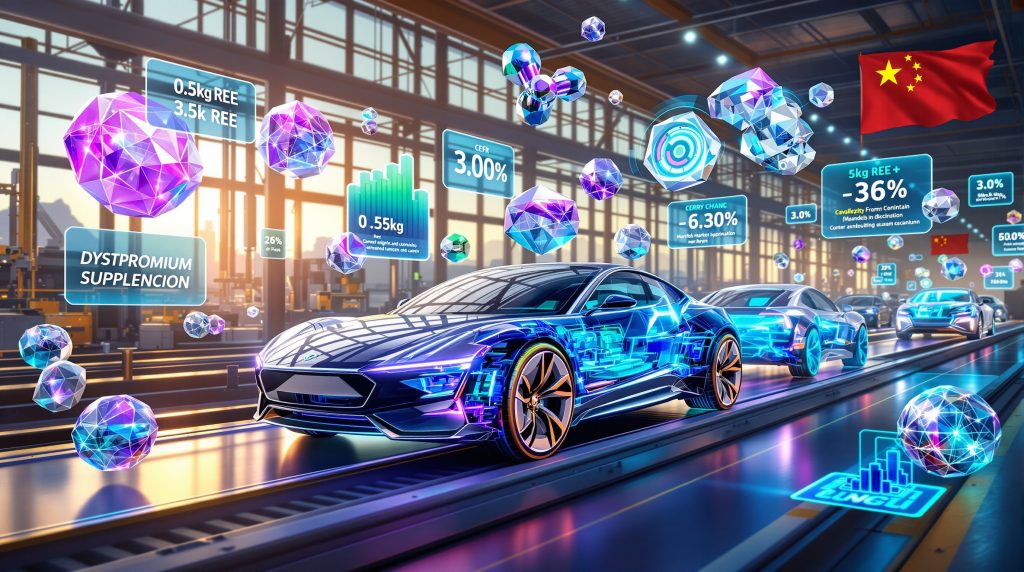The rare earths in auto industry sector relies on seventeen specialized metallic elements that form the technological backbone of contemporary vehicle manufacturing. These elements, known as rare earth elements (REEs), enable critical functions ranging from steering precision to advanced exhaust management systems, making them irreplaceable components in both traditional combustion vehicles and emerging electric platforms. Moreover, the critical minerals energy transition has elevated their strategic importance significantly.
A comprehensive supply chain audit revealed that automotive manufacturers maintain relationships with over 6,000 suppliers incorporating rare earth materials somewhere within the production ecosystem. This distributed dependency creates an intricate web where microscopic material shortages can cascade into production line shutdowns affecting facilities valued in billions of dollars.
Essential Elements: Understanding the Foundation of Modern Vehicles
Technological Applications Across Vehicle Systems
The primary applications of rare earth materials center around neodymium-iron-boron (NdFeB) magnet systems that power essential vehicle functions. These permanent magnets operate within electric motors controlling steering mechanisms, window regulators, seat adjustments, and audio speaker systems. The magnetic properties achieved through rare earth integration cannot be replicated using conventional ferrite or aluminum-nickel-cobalt alternatives without significant performance degradation.
Catalytic converter systems represent the second major application category, where cerium oxide serves as the active component for exhaust emission reduction. This ceramic compound facilitates the chemical conversion of harmful combustion byproducts into less toxic compounds, making it essential for regulatory compliance across global automotive markets.
| Rare Earth Element | Primary Function | Vehicle System | Typical Content Range |
|---|---|---|---|
| Neodymium | Permanent magnetism | Motor assemblies | 0.5-3 kg per vehicle |
| Praseodymium | Magnetic enhancement | Efficiency optimization | 200-800g per vehicle |
| Cerium | Oxidation catalyst | Emission control | 100-500g per vehicle |
| Lanthanum | Battery electrolyte | Energy storage | Up to 15 kg (hybrids) |
| Dysprosium | High-temperature stability | Performance motors | 50-200g per vehicle |
Critical Material Dependencies
Crystal structure requirements explain why rare earth elements remain technically irreplaceable in current automotive applications. Neodymium-iron-boron magnets achieve their exceptional performance through specific atomic arrangements where neodymium atoms provide magnetic anisotropy, iron contributes magnetic moment, and boron creates crystallographic stability. Alternative magnetic materials cannot simultaneously deliver equivalent strength, temperature resistance, and compact packaging characteristics.
The Curie temperature specifications for automotive magnets require operational stability above 150°C for under-hood applications, with premium performance motors demanding stability beyond 200°C. Dysprosium and terbium additions enable these temperature requirements by increasing the coercivity of neodymium-based magnets, though these heavy rare earths represent the most supply-constrained elements in the periodic table.
Electric Vehicle Transformation: Amplifying Material Requirements
Electric vehicle adoption has fundamentally altered rare earth demand patterns within the automotive industry, creating concentrated material requirements that exceed conventional vehicle consumption by factors of two to six. This transformation reflects the technological convergence around permanent magnet synchronous motors (PMSM), which have become the dominant powertrain architecture for electric mobility applications.
Quantified Demand Escalation
Current market analysis indicates that conventional internal combustion vehicles contain approximately 500 grams of rare earth materials distributed across various subsystems. Electric vehicles, by contrast, require 1-3 kilograms of neodymium-based magnets exclusively for motor applications, representing a dramatic concentration of material dependency within single components.
Hybrid vehicle platforms occupy an intermediate position with approximately 5 kilograms of total rare earth content. The Prius-class hybrid architecture incorporates a 1-kilogram neodymium motor assembly combined with nickel-metal hydride battery packs containing up to 15 kilograms of lanthanum. This battery chemistry utilizes lanthanum-nickel-five (LaNi₅) crystal structures that enable hydrogen absorption and release cycles essential for energy storage functionality.
Industry Analysis: Approximately 95% of electric vehicle manufacturers have standardised on permanent magnet synchronous motor technology, creating unprecedented concentration of demand for specific rare earth elements across the entire automotive sector.
Motor Technology Convergence
The dominance of PMSM technology stems from quantified performance advantages over alternative motor designs. Permanent magnet motors achieve torque density ratings of 250-400 Newton-meters per kilogram, compared to induction motors delivering 150-250 Nm/kg. This performance differential enables compact motor packaging essential for vehicle integration while maintaining acceleration characteristics demanded by consumers.
Efficiency specifications provide additional justification for rare earth dependence. PMSM systems operate at 92-96% efficiency across normal driving conditions, while magnet-free alternatives typically achieve 88-93% efficiency. The 3-5 percentage point differential directly impacts battery range and regulatory compliance with evolving fuel economy standards.
Regenerative braking capabilities represent a third performance dimension where permanent magnet motors excel. The predictable magnetic field characteristics enable precise energy recovery during deceleration, contributing 15-25% of total vehicle efficiency in urban driving cycles.
Alternative Battery Chemistry Considerations
Lithium-ion battery systems currently utilised in most electric vehicles contain minimal rare earth content, representing a strategic advantage compared to hybrid nickel-metal hydride designs. However, emerging high-energy-density battery chemistries under development may incorporate rare earth elements to achieve performance targets beyond current lithium-ion capabilities.
Solid-state battery research indicates potential applications for lanthanum and cerium in ceramic electrolyte formulations designed to improve ionic conductivity and thermal stability. These next-generation systems remain in development phases but could alter the rare earth demand profile for electric vehicles beyond 2030.
China's Strategic Market Control: Vertical Integration Dominance
China's position within global rare earth markets extends far beyond mineral extraction, encompassing comprehensive control across the entire value chain from mining operations through finished magnet manufacturing. This vertical integration creates multiple dependency points that compound supply vulnerability for international automotive manufacturers. Furthermore, recent developments such as the Trump executive order on critical minerals have intensified focus on these vulnerabilities.
Comprehensive Market Control Metrics
Current market share analysis reveals China's dominance across four critical supply chain stages:
- Raw material extraction: 70% of global mining operations
- Separation and processing: 85-90% of refining capacity
- Intermediate manufacturing: 80-85% of refined metal production
- Finished magnet production: 95% of global manufacturing capacity
The escalation from 70% mining control to 95% magnet manufacturing indicates that even rare earth materials extracted outside China typically require Chinese processing and manufacturing services before final automotive integration. This creates unavoidable dependency regardless of mining diversification efforts.
Processing Technology Barriers
Separation chemistry complexity explains China's sustained processing dominance beyond simple resource availability. Rare earth ores typically contain 15-30 different lanthanide elements requiring sophisticated separation using organophosphorus extractants combined with pH gradient stripping techniques. The process development and optimisation accumulated over decades creates significant barriers for competitors attempting to establish alternative processing capacity.
Environmental compliance costs provide additional competitive advantages for Chinese processors. Rare earth separation generates substantial quantities of acidic wastewater and radioactive tailings requiring expensive treatment and long-term storage. Chinese facilities have historically operated with lower environmental compliance costs, enabling price advantages of $3,000-5,000 per metric ton compared to Western processing estimates.
Strategic Export Control Implementation
Recent export licensing requirements have demonstrated China's willingness to utilise rare earth supply as geopolitical leverage. The 2025 Ford Explorer production suspension exemplifies the vulnerability created by this dependency, where missing magnetic components valued at approximately $40 halted production of vehicles worth $40,000 each, representing a 1,000:1 value ratio disparity.
Historical precedent from the 2010 Japan export halt established the pattern of supply disruption as diplomatic pressure. During this incident, Honda and Toyota were compelled to implement emergency motor redesigns to reduce rare earth content whilst maintaining performance specifications. The disruption lasted several months despite affecting only Japanese manufacturers, indicating the potential scope of broader export restrictions according to CNBC's analysis of China's rare earth curbs.
Strategic Assessment: Future supply disruptions should be understood as intentional policy instruments rather than market-driven events, fundamentally altering risk assessment frameworks for automotive supply chain management.
Automotive Industry Response: Building Supply Chain Resilience
Leading automotive manufacturers have implemented comprehensive strategies to reduce Chinese dependency through direct partnerships with Western rare earth producers, alternative technology development, and strategic stockpiling programmes. These initiatives represent the industry's recognition that rare earths in auto industry applications represent systemic vulnerability requiring proactive mitigation.
Strategic Partnership Development
General Motors-MP Materials Agreement: This long-term offtake contract secures neodymium and praseodymium supply from the Mountain Pass mine in California, representing the most significant North American rare earth partnership in the automotive sector. The agreement includes guaranteed volume commitments estimated at 5,000-10,000 metric tons annually with pricing mechanisms tied to market indices rather than Chinese export policies.
Hyundai/Kia-Arafura Resources Contract: The seven-year neodymium-praseodymium supply agreement with the Australian Nolans Project provides geographic diversification beyond North American sources. This partnership includes technology transfer provisions for rare earth processing and potential equity participation in mining operations.
| Automotive Company | Supply Partner | Agreement Structure | Geographic Region | Material Focus |
|---|---|---|---|---|
| General Motors | MP Materials | Long-term offtake | North America | NdPr concentrate |
| Hyundai/Kia | Arafura Resources | 7-year contract | Australia | NdPr metals |
| Schaeffler | REEtec | Processing agreement | Europe | Finished magnets |
| Stellantis | Multiple suppliers | Portfolio approach | Global | Diversified REEs |
Government Support Infrastructure
U.S. Department of Defense funding totalling hundreds of millions of dollars has been allocated to domestic rare earth processing capacity development. MP Materials and Lynas Corporation have received substantial investments targeting 2027 completion of integrated American refining capabilities. This timeline represents critical infrastructure development for reducing Chinese processing dependencies.
European Raw Materials Alliance (ERMA) has established targets for 20% of EU magnet demand to be sourced domestically by 2030. This initiative combines government funding with private sector investment to establish integrated European rare earth processing and magnet manufacturing capacity.
Strategic Stockpiling Programmes
Major automakers have extended rare earth inventory positions from typical 30-90 day operating supplies to 6-12 month strategic reserves. This stockpiling approach provides buffer capacity against supply disruptions whilst creating time for alternative supply source activation, particularly as governments develop their critical minerals strategic reserve.
Inventory management strategies now incorporate dual-source procurement requirements where primary Chinese suppliers provide 60-70% of material requirements, whilst Western alternatives supply 20-30%, with emergency reserves accounting for the remaining 10% allocation.
Engineering Solutions: Reducing Rare Earth Dependencies
Automotive manufacturers are pursuing technological approaches to eliminate or substantially reduce rare earth requirements through alternative motor designs and material substitution research. These solutions involve engineering trade-offs that must be carefully balanced against performance requirements and cost considerations, reflecting broader mining industry evolution trends.
Magnet-Free Motor Technologies
Synchronous reluctance motors eliminate rare earth requirements entirely whilst maintaining reasonable efficiency characteristics. These designs achieve 88-91% efficiency compared to 92-96% for permanent magnet systems, representing a 3-5 percentage point performance penalty that translates to approximately 5-8% reduced battery range in electric vehicle applications.
Induction motor systems pioneered by Tesla require minimal rare earth content whilst delivering reliable performance characteristics. These designs incur 15-25% weight penalties compared to permanent magnet equivalents but provide superior controllability and reduced material cost vulnerability.
Switched reluctance motors represent the most aggressive rare earth elimination approach, utilising electromagnetic switching rather than permanent magnetism. Current limitations include higher noise levels and more complex control electronics, though development programmes are addressing these challenges through advanced switching algorithms and acoustic dampening techniques.
Advanced Material Substitution
Honda-Daido Steel breakthrough: The development of heavy rare earth-free neodymium magnets represents significant technological advancement using nanostructure engineering to eliminate dysprosium and terbium requirements. These magnets maintain high-temperature performance through grain boundary optimisation rather than heavy rare earth additions.
Toyota's substitution programme has achieved 20-50% neodymium reduction through lanthanum and cerium integration in specific motor applications. This approach leverages abundant light rare earth elements to partially replace supply-constrained neodymium whilst maintaining acceptable performance characteristics.
BMW's magnet-free initiatives include development of synchronous motors utilising ferrite magnets combined with advanced rotor designs. These systems target cost reduction and supply security whilst accepting modest performance compromises in non-critical applications.
Performance Trade-Off Analysis
Quantified comparison data for alternative motor technologies:
- Torque density reduction: 15-30% compared to permanent magnet systems
- Efficiency penalty: 2-5 percentage points across normal operating ranges
- Weight increase: 20-40% for equivalent power output
- Cost implications: 15-25% manufacturing cost reduction through material substitution
- Development timeline: 3-5 years for complete system validation and production readiness
Recycling Revolution: Circular Economy Implementation
The emergence of rare earth recycling capabilities represents a strategic opportunity to reduce mining dependence and Chinese supply control through circular economy principles. Current recycling rates remain below 1% for rare earth magnets, but technological development and regulatory support are accelerating recovery infrastructure deployment. Meanwhile, innovations like the recent battery recycling breakthrough demonstrate the potential for significant advances in this field.
Urban Mining Potential
End-of-life vehicle processing will become increasingly significant as the first generation of electric vehicles approaches retirement around 2030-2035. Each retired electric vehicle contains 1-3 kilograms of recoverable rare earth materials within motor assemblies, potentially providing substantial secondary supply sources.
Recycling process technology involves three primary stages: mechanical disassembly of electric motors, chemical separation of rare earth elements using acid leaching techniques, and remanufacturing into new permanent magnets. Current pilot programmes achieve 85-95% rare earth recovery rates from processed motors.
European and Japanese Leadership
EU recycling initiatives are scaling magnet-to-magnet recovery processes with targets for significant circular supply contribution by 2030. These programmes combine automotive manufacturer take-back requirements with specialised recycling facility development to create closed-loop material flows.
Japanese urban mining programmes have demonstrated commercial viability for rare earth recovery from electronic waste streams. Technology transfer from consumer electronics recycling is being adapted for automotive applications with improved efficiency and cost-effectiveness.
Projected recycling timeline:
- Current status: Less than 1% of rare earth magnets recycled globally
- 2030 projection: 15-20% recovery rate from automotive sources
- 2035 target: 30-40% of supply from circular economy sources
- Technology readiness: Commercial pilot programmes operational across multiple regions
Supply-Demand Dynamics: Critical Timeline Analysis
Industry forecasting indicates that neodymium demand will increase by 70% between 2025 and 2030, driven primarily by electric vehicle adoption acceleration and renewable energy infrastructure development. This demand growth will occur during a period when existing mining capacity approaches maximum output, creating potential for severe supply constraints.
Demand Growth Projections
Electric vehicle market expansion represents the primary demand driver, with global EV sales projected to reach 50-60 million units annually by 2030. Each vehicle requiring 1-3 kilograms of neodymium magnets translates to 50,000-180,000 metric tons of additional annual neodymium demand from automotive sources alone.
Wind turbine installations provide secondary demand pressure, with each megawatt of wind generation capacity requiring approximately 150-200 kilograms of rare earth magnets. Global wind capacity additions of 100-150 gigawatts annually create substantial competing demand for automotive applications.
Critical Supply Constraints Timeline
2025-2027 period: Existing mines approach capacity limitations whilst new Western projects remain under development. Chinese export policies may become increasingly restrictive during this period, creating potential for supply shortages as highlighted by Reuters' coverage of carmaker concerns.
2027-2029 transition: New Western mining operations including MP Materials expansion and Australian projects begin commercial production. However, processing capacity limitations may create bottlenecks even with increased mining output.
2029-2031 peak tension: Maximum supply-demand imbalance period where new mine production has not yet reached full capacity whilst demand continues accelerating. This period presents highest risk for significant price volatility and supply disruptions.
2031-2035 stabilisation: Recycling streams reach commercial maturity whilst Western mining capacity approaches steady-state production levels, reducing Chinese dependency and supply vulnerability.
Heavy Rare Earth Bottlenecks
Dysprosium and terbium face the most severe supply constraints with virtually all production remaining under Chinese control through 2030. These elements are essential for high-performance motors in premium electric vehicles, creating potential for technological bottlenecks in the performance vehicle segment.
Price volatility implications: Heavy rare earth prices may experience 2-3x increases during peak demand periods, potentially forcing automotive manufacturers to accelerate alternative technology development or accept reduced performance specifications.
Emerging Mining Projects: Western Supply Development
New rare earth mining initiatives across Australia, North America, and Europe are progressing through development phases with targeted production dates between 2027-2032. These projects represent critical infrastructure for reducing Chinese supply dependence but require sustained investment and regulatory support for successful completion.
Australian Resource Development
Lynas Rare Earths expansion: The Mount Weld operation represents the largest non-Chinese rare earth producer with expansion plans targeting doubled production capacity by 2030. Current output focuses on light rare earth elements with potential for heavy rare earth development.
Arafura Resources Nolans Project: Located in Northern Territory, this development targets 12,000 metric tons per annum of rare earth oxide production with emphasis on neodymium and praseodymium for automotive applications. Commercial production is scheduled for 2027 with long-term offtake agreements already secured.
Iluka Resources Eneabba facility: This Western Australian project focuses on integrated rare earth refining capability rather than mining, providing processing services for multiple mining operations and reducing Chinese refining dependence.
North American Mining Initiatives
MP Materials Mountain Pass expansion: California facility represents the only operational rare earth mine in North America with expansion plans targeting integrated processing capability by 2027. Current production focuses on concentrate exports with domestic processing development underway.
Energy Fuels White Mesa facility: Utah-based uranium processing operation has added rare earth recovery capabilities from monazite sands, providing diversified rare earth production integrated with existing nuclear fuel operations.
Canadian exploration programmes: Multiple projects including Appia Rare Earths and Defense Metals are advancing through feasibility studies with potential production dates in the early 2030s.
Investment Requirements and Development Timelines
Capital investment analysis: New integrated rare earth mining and processing operations typically require $500 million to $2 billion in capital investment depending on scale and processing complexity. Development timelines from discovery to commercial production average 7-10 years including permitting and construction phases.
| Project | Location | Target Production | Timeline | Investment Required |
|---|---|---|---|---|
| Nolans Project | Australia | 12,000 tpa REO | 2027 | $1.2 billion |
| Mountain Pass | USA | 15,000 tpa concentrate | 2027 processing | $800 million |
| Eneabba Refinery | Australia | Processing services | 2028 | $500 million |
| White Mesa REE | USA | 2,000 tpa mixed REE | Operating | $200 million |
Geopolitical Risk Management: Adaptive Strategies
The automotive industry's response to geopolitical rare earth risks involves multi-dimensional strategies combining supply diversification, technology development, and strategic planning for potential supply disruption scenarios. These approaches recognise that complete supply independence remains economically impractical whilst risk distribution provides measurable vulnerability reduction.
Dual-Source Procurement Framework
Primary supplier allocation: Chinese sources continue providing 60-70% of rare earth requirements due to cost advantages and established processing capacity. This dependency reflects economic reality rather than strategic preference.
Secondary supplier development: Western alternatives receive 20-30% allocation to maintain alternative supply chains and provide competitive pressure on Chinese pricing. These relationships require premium payments to support non-Chinese capacity development.
Emergency reserve management: Strategic stockpiles provide 10% of annual consumption in reserve status, offering buffer capacity during supply disruptions whilst alternative sources activate.
Scenario Planning Implementation
Supply disruption response protocols include predetermined supplier activation sequences, alternative technology deployment timelines, and production adjustment procedures for extended supply constraints. These plans are regularly updated based on evolving geopolitical conditions and alternative supply development progress.
Technology transition readiness: Automotive manufacturers maintain parallel development programmes for magnet-free motor technologies that can be accelerated if rare earths in auto industry supply becomes severely constrained. These backup systems accept performance compromises in exchange for supply security.
Future Industry Transformation: 2025-2040 Outlook
The automotive industry's relationship with rare earth materials will evolve through distinct phases characterised by continued dependence, accelerated diversification, and eventual circular economy maturation. Success in managing this transformation will require sustained investment, international cooperation, and technological advancement across the entire rare earth value chain.
Technology Evolution Roadmap
2025-2028 continued dependence period: Current rare earth-intensive designs remain dominant whilst alternative technologies undergo development and validation. Western mining capacity begins commercial operations but remains insufficient for complete supply independence.
2028-2032 diversification acceleration: Alternative motor technologies achieve commercial readiness whilst Western processing capacity reaches meaningful scale. Recycling programmes demonstrate commercial viability and begin significant supply contribution.
2032-2040 circular economy maturation: Recycling provides 25-30% of rare earth supply whilst alternative technologies capture 25% of new vehicle production. Chinese supply dependence reduces to 40-50% of total requirements.
Success Metrics for Supply Chain Resilience
Quantified targets for industry transformation:
- Western processing capacity: 40% of global rare earth refining by 2035
- Alternative motor adoption: 25% of new electric vehicles using magnet-free designs by 2032
- Recycling contribution: 30% of automotive rare earth supply from circular sources by 2035
- Price volatility reduction: Annual price fluctuations below 20% through supply diversification
Investment requirements: The automotive industry and supporting government programmes will need to invest an estimated $50-75 billion globally in alternative supply infrastructure, technology development, and recycling capacity between 2025-2035.
Strategic Recommendations
For automotive manufacturers:
- Accelerate alternative technology development whilst maintaining dual-source procurement
- Invest in recycling infrastructure development and take-back programmes
- Establish strategic partnerships with Western rare earth producers
- Develop flexible manufacturing systems capable of rapid technology transition
For government policy:
- Maintain financial support for domestic rare earth capacity development
- Establish strategic reserve programmes for critical materials
- Support research and development of alternative technologies
- Coordinate international cooperation on supply chain resilience
The automotive sector's rare earth challenge represents both critical vulnerability and innovation catalyst. Whilst current dependencies create significant risks, the comprehensive industry response through diversification, technological development, and circular economy implementation positions the sector for enhanced long-term resilience. Successful navigation of this transition requires sustained commitment to investment, technological advancement, and international cooperation across the entire rare earth value chain.
The transformation from complete Chinese dependence to diversified supply networks will fundamentally reshape automotive manufacturing over the next decade. Companies and nations that successfully develop alternative supply sources, advanced technologies, and circular economy capabilities will secure competitive advantages in the electrified transportation future, whilst those that fail to adapt face potential supply chain vulnerabilities that could compromise market position and operational continuity.
Ready to Position Yourself in Australia's Mining Boom?
Discovery Alert's proprietary Discovery IQ model delivers instant notifications on significant ASX mineral discoveries, including critical rare earth elements essential for the automotive industry's future. With major mining projects like Arafura Resources' Nolans Project approaching commercial production, subscribers gain immediate access to actionable opportunities before broader market recognition. Start your 30-day free trial today to secure your competitive advantage in Australia's evolving mining landscape.




